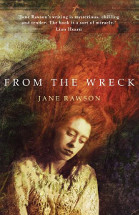From the wreck by Jane Rawson

Transit Lounge, 2017. ISBN 9780995359451
(Age: Senior secondary - adult) Jane Rawson has used one story, the
shipwreck, from which she creates a world built around one
survivor's life, and draws us deeply into his life. As another
layer, she has interwoven a strange world of beings who may or may
not be there, but which, once imagined, haunt those in whose lives
they 'exist'. It is in this dimension that she deftly controls the
novel so that it remains credible, interesting and perhaps
'fantastic' in the true meaning of the word. In this layer we
experience the idea of another world of beings, and of a haunting,
both by a spirit in the body of a possibly real character, and
another layer, that of the even more enigmatic birthmark.
Yet again, in another layer of existence, is an historically real
world. Here are the people who have been displaced, those indigenous
to Australia, into whose world the newcomers barge, taking land and
place and animals, tearing up the precious earth and covering the
land with farms, where they can do so. Theirs is a subtler presence.
The imaginative reconstruction of this world is drawn deftly and
believably, and we have no problem accepting the reality of their
lives, devastating as these are for so many people. The perils of
getting to Australia from the old world are ever present, and the
shipwrecks are just one of those perils.
The calling up of our emotions and imagination, as we are drawn into
the experience of the boy, whose brother's fate is blamed on him,
evokes strong responses. As the story progresses, Rawson elicits an
enormous feeling of desire in the reader to lift the dreadful burden
from the young boy, and, as we see how he is suffering, we are drawn
to feel deeply for him in his puzzling loss. We become aware that he
is perplexed and burdened by a guilt he can neither explain nor
comprehend, and a sorrow that is unrelieved.
This is certainly a strongly constructed story, one that would be
suitable for older adolescents, and for all readers interested in
the history of this country as a lived experience that we can only
know through story. Beautifully written, in luminous prose and rich
detail of early South Australia, this story resonates with the
reality of establishing a colony and a new life for the immigrants
and those born in this new world. Whether it is seen as fiction or a
combination of fact and fiction, this story challenges us to
consider some of the darker incidents of our history.
Liz Bondar